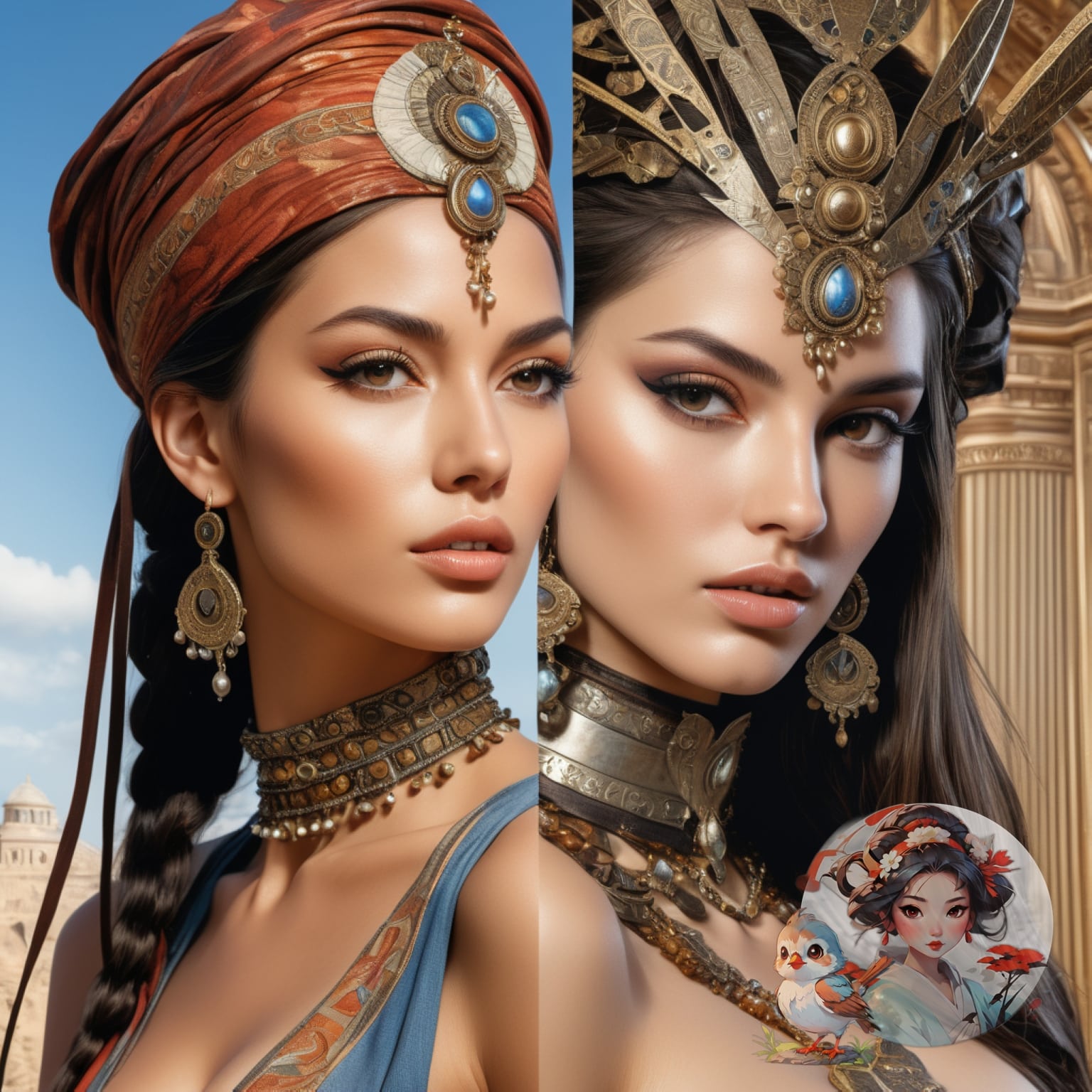In Japan we have a concept called “honne” and “tatemae” – the contrast between outward appearance and inner beauty. When I think about attractiveness and artistic beauty, I think about these principles. Attractiveness is like a delicate cherry blossom, captivating our senses with its immediate charm. Artistic beauty, on the other hand, is like a carefully crafted woodblock print – its appeal unfolds with each subtle nuance and intricacy.
What fascinates me is how our perception of beauty changes, like the changing seasons, as we encounter different stimuli. The intricate design of a kimono can evoke a sense of elegance, while a deliberate, expressive brushstroke in a painting can convey the depths of human experience. Observing these varied responses, I’ve come to realise that beauty is not fixed; it’s a dynamic interplay of multiple elements.
Let’s take the example of traditional Japanese skin care rituals. We use ingredients such as green tea and rice bran to cultivate a calm, radiant complexion. This gentle, gradual approach to beauty contrasts with the instant appeal of, say, a vibrant Kabuki performance. One is an unfolding, meditative process, the other a fleeting spectacle. By understanding these different aspects of beauty, we can refine our appreciation of the subtleties at play.
In judging beauty, we must acknowledge the influence of cultural and personal contexts. In Japan, the concept of ‘wabi-sabi’ (acceptance of imperfection) informs our aesthetic, while in other cultures perfection may be the ideal. Recognising these different perspectives allows us to engage with beauty on a richer, more nuanced level. As we navigate the interplay between attractiveness and artistic beauty, we may discover that the most compelling expressions of beauty lie in the intricate balance between instinct and deliberation, surface and depth.
Table of Contents
ToggleThe intricacies of attractiveness and artistic beauty. In our quest to understand these concepts, research has shed light on the different perceptual processes at play. One recent study caught my attention because it highlighted the importance of personal preferences in shaping our perceptions of beauty.

When I think about attractiveness, I think about physical attractiveness – the fine features, the glowing complexion. But artistic beauty is a very different story. It weaves a rich tapestry of creative and cultural influences, each strand a testament to the diversity of human experience. Take, for example, the revered art of Kabuki. Those majestic, stylised movements and dramatic make-up designs challenge our conventional notions of beauty, don’t they?
Cultural influences, in particular, wield considerable power over our understanding of beauty. In Japan, we have an ancient tradition of celebrating the transience of life. Our concept of “wabi-sabi” (acceptance of transience) reminds us to appreciate the imperfections and impermanence that make life beautiful. This perspective has shaped our standards of beauty, where subtlety and restraint are often preferred to overt displays.
As we strive for a more nuanced and inclusive understanding of beauty, we must acknowledge these differences. By embracing the diversity of human experience and perception, we can distill the essence of beauty in all its forms. I’m reminded of the meticulous art of traditional Japanese beauty care, where every gesture and movement is a testament to the pursuit of elegance. Beauty in all its forms is a reflection of our common humanity.
I’d like to take you through the intricacies of our study of attractiveness and artistic beauty. Two behavioural experiments formed the core of our research, each with different aims and procedures. We carefully controlled the demographics of the participants to ensure the validity of the experiment. Our participants, 60 people aged 18-31, were carefully recruited with an equal balance of men and women.
Art portraits and landscapes were rated using a continuous rating scale and random phase Fourier masks. These masks helped to minimise afterimages and allowed participants to focus on the artwork without distraction. By using this methodology, we aimed to disentangle the perceptual differences between attractiveness and artistic beauty. Our findings would provide valuable insights into the cognitive processes underlying aesthetic judgments.
A closer look at our experimental design reveals a thoughtful approach to understanding the complex interplay between immediate visual perception and reflective evaluation. We avoided a simplistic view of beauty, opting instead for a nuanced exploration of the factors that contribute to our appreciation of art. This rigorous approach enabled us to shed light on the intricacies of aesthetic judgments, revealing the subtle but crucial differences between attractiveness and artistic beauty.
In our quest for knowledge, we remained grounded in evidence, avoiding hyperbole and relying on empirical data to support our claims. This philosophy guided our study, resulting in a rich tapestry of findings that underscore the multifaceted nature of beauty and art appreciation. By embracing the complexity of our subject, we were able to distill valuable insights that contribute meaningfully to our understanding of the human experience.
The art of presentation time. A delicate balance that can make or break our perception of beauty. In the field of aesthetics, it’s a crucial element that has been studied extensively. Our research, rooted in traditional Japanese beauty care, reveals a fascinating distinction between attractiveness and artistic beauty.

Attractiveness ratings, we found, are more susceptible to the influence of brief exposure times. A fleeting glance can elicit an immediate response, driven by immediate visual perception. In contrast, ratings of artistic beauty remain relatively stable across different presentation durations. This suggests that artistic beauty relies on more cognitive processing over longer viewing periods.
To understand the effect of presentation time on aesthetic judgments, perceptual accuracy is key. It’s a concept deeply rooted in traditional Japanese aesthetics, where the nuances of beauty are carefully considered. By studying the interplay between presentation time and aesthetic judgments, we can gain a deeper understanding of the complex processes underlying human perception and appreciation of art.
Traditional Japanese beauty practices emphasise the importance of patience and mindfulness. A slow and deliberate approach allows for a deeper appreciation of beauty. Similarly, our findings suggest that artistic beauty requires a more contemplative approach that goes beyond a brief, initial impression.
Aesthetic judgments are a complex interplay of immediate visual perception and reflective cognitive processing. The results of our study reveal a fascinating disparity between judgments of attractiveness and judgments of artistic beauty, highlighting the different mechanisms at work.
When we’re exposed to a work for a short time, our immediate engagement has a more profound effect on attractiveness ratings. Emotional resonance plays a significant role in shaping our aesthetic preferences, and cultural influences also contribute to individual tastes. I am reminded of the importance of mono no aware – the fleeting nature of beauty – in traditional Japanese aesthetics, where transience is valued.
In contrast, artistic beauty is evaluated through a more cognitive, reflective process. Our study suggests that we take the time to consider artistic value by examining the composition, colours and techniques used. This thoughtful approach allows us to appreciate the subtleties and nuances that make a work truly remarkable.
These findings have significant implications for our understanding of aesthetic judgments, revealing that attractiveness and artistic beauty are not interchangeable terms. By recognising the different processes at play, we can refine our appreciation of beauty and cultivate a deeper understanding of what makes something truly stunning. As I always say, “Kokoro kara miru” – to see with the heart – is essential to appreciating the true essence of beauty.
The delicate balance of aesthetic judgement. As someone who has spent years studying the art of traditional Japanese beauty, I can attest to the profound impact of visual context on our perception of beauty. Surrounding elements, such as the gentle curve of a cherry blossom branch, can enhance the speed and efficiency of object recognition and influence our assessment of the aesthetic value of a work of art.
Consider the subtle interplay of lighting, colour palette and composition – a symphony of visual cues that can enhance or diminish our appreciation of a work. I recall a study in which the same artwork, displayed in different environments, elicited different levels of aesthetic appreciation. This finding underlines the importance of recognising contextual factors when judging beauty.
In the tranquil world of traditional Japanese aesthetics, we understand the importance of harmony between visual elements. The soft glow of candlelight, the muted tones of a winter landscape or the bold strokes of a calligrapher’s brush – each element contributes to a rich tapestry of beauty. By recognising the intricate dance between visual cues and contextual influences, we can free ourselves from preconceived notions and prejudices, much like the gentle shedding of autumn leaves.
As we navigate the complex realm of aesthetic judgement, it is essential to approach each piece with an open heart and mind, allowing the unique harmony of visual elements to guide our appreciation. By adopting this mindful approach, we can deepen our understanding of the multifaceted nature of beauty, just as the gentle rains of spring nourish the blossoming gardens of our souls.
A fascinating topic in the field of aesthetic evaluation is the distinction between beauty and attractiveness ratings. I’d like to share with you some findings from recent studies that shed light on the unique processes that underlie these judgments.
When we judge attractiveness, our response tends to be immediate and visceral. In contrast, artistic beauty elicits a more cognitive and reflective evaluation. This difference is nicely illustrated by the results of Experiments 1 and 2. Attractiveness ratings were significantly influenced by brief exposure, whereas beauty ratings remained relatively stable across presentation times.
These results highlight the importance of considering both aesthetic preferences and emotional responses in understanding the complex dynamics of beauty and attractiveness judgments. The traditional Japanese concept of “yūgen” comes to mind, which values the deep and mysterious sense of beauty in the world. By acknowledging the multifaceted nature of aesthetic experience, we can gain a deeper understanding of what makes something truly beautiful.
The nuances of aesthetic experience are diverse and far-reaching. In the context of traditional Japanese beauty care, for example, the emphasis is on cultivating a sense of inner beauty that radiates outward. This approach recognises that beauty is not only a physical quality, but also a reflection of one’s character and spirit. By considering the interplay between inner and outer beauty, we can develop a more holistic understanding of what it means to be beautiful.
The art of immediate perception – a subtle dance of cognitive processes that shapes our aesthetic preferences. I find it fascinating how attractiveness ratings can be influenced by brief exposure times. Studies have shown that a fleeting glance can significantly affect our emotional response to a work of art.
Beauty, especially artistic beauty, relies on more deliberate cognitive processing. Perceived fluidity and cognitive limitations both play a role in assessing the aesthetic value of art. In traditional Japanese culture, we value the subtlety of imperfection and often find beauty in the imperfect, the unstable, and the incomplete.

To understand the impact of immediate perception, it’s important to consider both visual engagement and cognitive evaluation. Researchers have shown that structural and semantic elements can be grasped within brief presentations, often eliciting an immediate emotional response. By understanding these mechanisms, we gain insight into the complex dynamics that govern our emotional and rational responses to art.
When applied to traditional Japanese beauty care, this knowledge allows for a nuanced approach to enhancing one’s natural beauty. For example, a simple yet elegant hairstyle can effortlessly draw attention to the subtle features of the face. Similarly, a carefully applied layer of Oshiroi (white face powder) can create a harmonious balance of skin tones, much like the carefully balanced brushstrokes on a canvas. By harnessing the power of immediate perception, we can transcend mere physical appearance and touch the heart of beauty itself.
As we delve into the complexities of aesthetic perception, our next research steps should focus on the interplay between immediate perception, cognitive processing, and contextual influences on attractiveness and artistic beauty judgments. I find the dynamics of gender representation in art particularly intriguing, as it raises questions about how societal norms and expectations shape our perceptions.
When examining the impact of cultural differences on aesthetic preferences, it’s important to consider the complex relationships between individual taste, cultural background and artistic expression. I am reminded of the traditional Japanese concept of wabi-sabi, in which imperfection is valued as a natural part of beauty. This perspective can reveal the rich diversity of beauty standards across cultures.